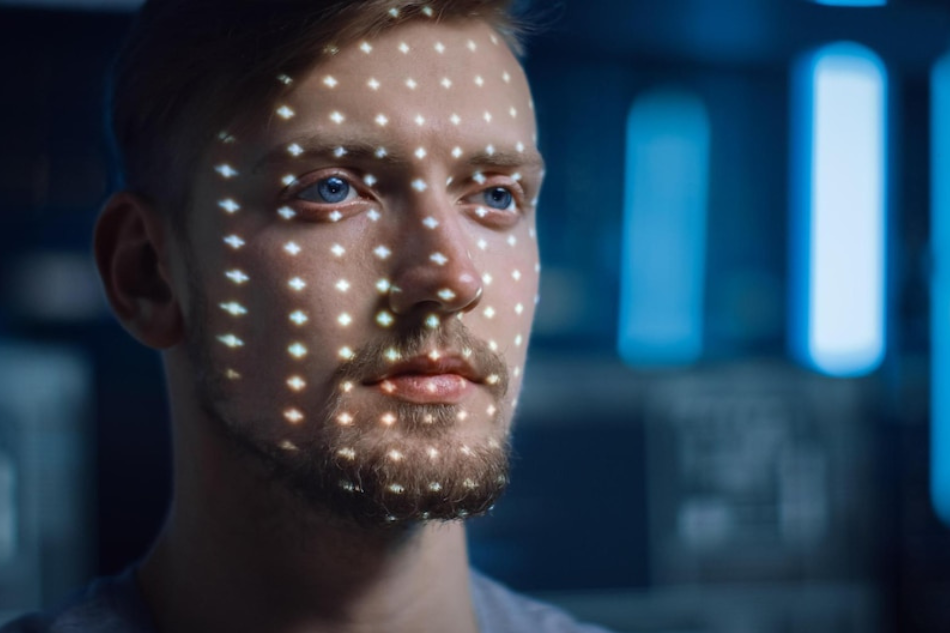Passive liveness detection confirms user presence without requiring active user participation. It relies on algorithms to analyze biometric data like a facial image for authenticity.
In crafting a secure user authentication protocol, Passive Liveness Detection plays a pivotal role by ensuring that the individual participating in a verification process is real and present. This technology uses AI to evaluate various aspects such as texture, reflection, and depth in a given image.
Unobtrusive and user-friendly, passive liveness detection enhances security while maintaining an effortless user experience. As security measures against identity fraud evolve, this method provides a robust solution for real-time, seamless user verification across numerous applications, from mobile banking to access control.
Evolution Of Biometric Authentication
The Shift From Traditional Security Measures To Biometric Verification
Security has long been a game of cat and mouse between those seeking to protect assets and those attempting to breach defenses. Traditional security measures like passwords, PINs, and keycards have proven to be vulnerable to exploitation. The introduction of biometric verification was a significant shift in the security landscape, providing a more robust and personal layer of defense.- Fingerprint Scanners: Among the first widely adopted biometric technologies.
- Facial Recognition: Emerged as a user-friendly and highly effective biometric tool.
- Iris Recognition: Known for its high level of accuracy and security.

Importance Of Passive Liveness Detection In Preventing Fraud
As biometric systems gained popularity, so did the methods to deceive them. Enter the critical role of passive liveness detection, a technology designed to counteract presentation attacks such as the use of masks, photos, or videos to spoof biometric systems. Passive liveness detection differentiates between a real user and a fake representation without any active participation from the user. This silent sentinel operates in the background making it a game-changer in authentication:- Deters fraud by verifying the presence of a live person.
- Improves user experience by eliminating the need for active interaction.
- Enhances security by using advanced algorithms and AI.
Passive Vs Active Liveness Detection
In the rapidly evolving world of digital security, biometric verification stands out as a critical method of authenticating user identity. Within this realm, liveness detection has become a cornerstone for preventing spoofing attacks and ensuring that an actual live person is present during the verification process. There are two primary forms of liveness detection: passive and active. Each offers a different approach to deter fraudulent activities, with varying degrees of user interaction and technological sophistication.
| Aspect | Passive Liveness Detection | Active Liveness Detection |
|---|---|---|
| User Interaction | No interaction required | User must perform actions (e.g., blinking, smiling) |
| Technology | Advanced algorithms analyze a single image | Simpler algorithms require user-response to challenges |
| Intrusiveness | Non-intrusive, runs in the background | More intrusive, may disrupt user experience |
| Speed | Instantaneous, works with one image | Time-consuming, waits for user actions |
| Suitability | Preferred for customer-facing applications | Used in environments where active participation is viable |
Analysis Of Accuracy And User Experience
Diving deeper into the effectiveness of both systems, the accuracy of passive liveness detection is often highlighted. It utilizes sophisticated AI and machine learning algorithms that discreetly analyze nuances in a single image, such as texture, patterns, and depth, making it extremely difficult for spoofing attacks to succeed. Active liveness detection, while still reliable, generally relies on simpler technology that could potentially be deceived by more sophisticated spoofing techniques.
- Passive Liveness Detection
- Utilizes advanced AI technology.
- Typically more accurate due to its sophistication.
- Requires high-quality cameras for best results.
- Active Liveness Detection
- Depends on the user’s response to challenges.
- Accuracy may be compromised with advanced spoofing.
- Accessible across various devices with standard cameras.
The user experience also dramatically differs between the two. Passive liveness detection ensures a seamless authentication process, enhancing satisfaction and reducing abandonment rates, particularly important for customer-centric services. Conversely, active methods could introduce friction, requiring users to take specific actions that may be perceived as inconvenient.
- Passive Liveness Detection
- Improves overall user experience.
- Seamless and non-disruptive process.
- Reduces abandonment rates due to ease of use.
- Active Liveness Detection
- May interrupt the user’s natural flow.
- Poses a risk of creating user frustration.
- Potential for higher abandonment rates.
Advancing AI in Passive Liveness Detection
Advancing AI in Passive Liveness Detection
How Artificial Intelligence Powers Passive Liveness Checks
The core of passive liveness detection lies in AI-driven algorithms that analyze a myriad of data points from a single user interaction. Unlike traditional methods which require active participation from users, AI enables passive checks to conduct real-time liveness verification discreetly.- Capturing subtle facial movements and texture
- Analyzing lighting patterns and reflections
- Evaluating depth information
Benefits Of A Seamless And Non-intrusive Approach
One of the key advantages of a passive liveness detection is its non-intrusiveness. It ensures a frictionless user experience by eliminating the need for active participation, such as nodding or blinking. This approach presents multiple benefits:| Benefit | Description |
|---|---|
| Enhanced User Experience | Users undergo a verification process without any additional effort, cultivating a sense of ease and comfort. |
| Increased Security | Subtle and in-depth analyses make it difficult for fraudulent activities to bypass passive liveness detection. |
| Accessibility | Provides equal opportunities for all users to access services, irrespective of their familiarity with technology. |
| Broader Application | Can be easily integrated across diverse platforms, enhancing security measures in various domains. |
Enhancing Security With Passive Liveness Detection
Role Of Passive Liveness Detection In Boosting System Integrity
Passive liveness detection ensures that the entity interacting with a security system is a live person rather than a fake representation. Its role is pivotal in maintaining system integrity by silently verifying user authenticity in real-time. This non-intrusive method utilizes advanced algorithms to analyze biometric data, such as facial features, to confirm liveness without any active participation from the user. This, in turn, preserves a high level of trust and reliability in the security process.- Operates in the background: The verification process takes place without the users’ knowledge, ensuring a frictionless experience.
- Utilizes AI and machine learning: For detecting subtle signs of life not easily replicated by spoofing attempts.
- Highly scalable: Can be deployed across vast user bases with minimal impact on system resources.
Examples Of Security Breaches Mitigated By Passive Liveness Detection
Passive liveness detection has been instrumental in thwarting a myriad of security breaches. Below are instances where this technology has proven its mettle:| Type of Breach | Role of Passive Liveness Detection |
|---|---|
| Photo Spoofing | Passive liveness detection can differentiate between a live face and a photograph, effectively preventing photo-based identity fraud. |
| Deep fake | By analyzing the consistency of natural human movement, passive liveness detection identifies and rejects deep fake videos. |
| 3D Mask Attacks | Detects incongruities between a real human face and a mask by analyzing texture, reflection, and depth. |
| Replay Attacks | Identifies and denies entry when presented with recorded video by recognizing static image patterns. |
Deploying Passive Liveness Solutions

Best Practices For Integrating Passive Liveness In Various Sectors
Integrating passive liveness detection solutions requires a strategic approach tailored to each sector’s unique demands. Below, we highlight key best practices that sectors should consider:- Banking and Finance: Implement multi-modal biometric authentication that includes passive liveness checks to combat fraud effectively.
- Healthcare: Use passive liveness within patient identification systems to ensure HIPAA compliance and safeguard sensitive health data.
- Retail and E-commerce: Incorporate passive liveness into customer onboarding to streamline user experience without compromising on security.
- Government: Deploy passive liveness within identity verification services to prevent identity theft and ensure the accurate provision of services.
Challenges And Considerations In Practical Applications
When deploying passive liveness detection solutions, organizations might face a myriad of challenges:- User Privacy: Ensuring user data is handled with the utmost respect for privacy and in compliance with data protection regulations.
- Technology Integration: Integrating passive liveness technology with existing systems without causing downtime or degradation of service.
- System Adversaries: Preparing for and adapting to the latest presentation attack methods used by fraudsters.
Future Of Passive Liveness Detection Technology
Trends And Potential Advancements In Passive Liveness Detection Tech
The trajectory of passive liveness detection technology is set to revolutionize the way we think about and implement security measures. Here’s a look at some of the most exciting advancements on the horizon:- Deep Learning Improvements: As algorithms become more sophisticated, the accuracy of passive liveness checks will continue to improve, drastically reducing false positives and negatives.
- 3D Sensing Techniques: Emerging 3D imaging and sensing technologies will offer new ways to capture biometric data, enhancing passive liveness detection’s capabilities even further.
- Multi-Modal Biometrics: Integrating multiple biometric modalities like facial, iris, and voice recognition can bolster security systems, making passive liveness checks almost foolproof.
- Behavioral Biometrics: Analyzing patterns in user behavior, such as typing rhythm or mouse movements, might become an additional layer in passive liveness systems.
- Edge Computing: Processing data closer to the source can reduce latency and improve the real-time capabilities of liveness detection systems.
The Role Of Passive Liveness Detection In The Future Of Digital Security
As the digital world becomes more integrated into our daily lives, the need for robust security measures is undeniable. Passive liveness detection technology is set to play a pivotal role in this landscape for several reasons:- User Convenience: By not requiring any specific action, passive liveness checks deliver a seamless verification experience.
- Enhanced Security: Passive liveness detection offers a layer of security that is challenging to spoof, making it an integral component of anti-fraud measures.
- Regulatory Compliance: As regulations tighten around data protection and privacy, passive liveness detection ensures compliance without adding friction to the user experience.
- Scalability: The system’s ability to work effectively across various devices and platforms ensures that passive liveness detection can scale with growing demand.
- Inclusive Technology: With passive detection, accessibility and inclusivity are enhanced since it requires no physical interaction, catering to a broad range of users.
Frequently Asked Questions Of Passive Liveness Detection
What Is Passive And Active Liveness?
Passive liveness detection verifies identity without user interaction, while active liveness detection requires user actions, like moving the face or blinking.
What Is Passive Liveness Detection Techniques?
Passive liveness detection techniques authenticate users by analyzing biometric data, like facial features, without requiring any active user interaction.
What Is The Liveness Of A Fingerprint?
The liveness of a fingerprint is a system’s ability to detect if the fingerprint scan is from a live, present person or a fake representation.
How Do You Determine Liveness?
Liveness detection employs methods like analyzing texture, movement, and response to ensure a user is real, not a fake representation.
Conclusion
Embracing passive liveness detection technology marks a stride toward seamless and robust security solutions. It elevates verification processes without compromising the user experience. As we conclude, remember this approach is vital for combating fraud more discreetly and efficiently. By integrating passive liveness into their systems, businesses can enhance trust in their digital interactions.
It’s the silent guardian in the world of biometric security, working in the shadows to protect user identity.


